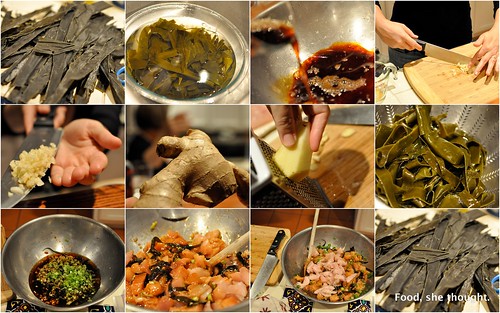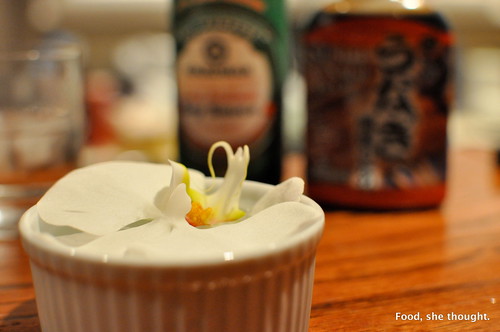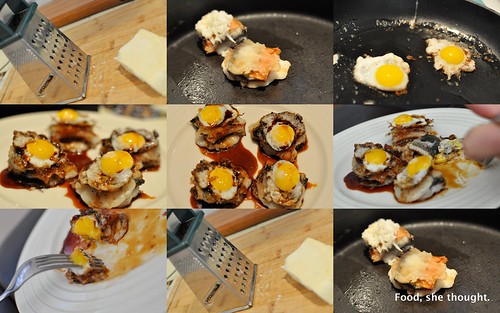The Classics
The challenge this time around:
Any food blogger worth their salt can make a classic dish sing, but can they go outside their comfort zone and tackle a foreign cuisine? We're bypassing the French and Italian standards in favor of more challenging cuisines.
Bloggers are to tackle a foreign cuisine outside the realm of one's normal blog practice to challenge our cooking and writing skills for this challenge. Although Hawaii is technically part of the United States, I feel very strongly it's an entity unto itself. Ask a few natives to expound on the topic, you will hear strong opinions about identifying with the U.S. And by native, I do not mean military or tourist. The more time I spend in Hawaii, the more the cuisine thrills me. And yet, I have never cooked it.
Anyone who follows this blog or my life in general knows of my familial involvement and frequent visits to Hawaii. D and I often comment that we feel Hawaii is less like this country's newest state and more like its own country, floating alone out there in the warm equatorial Pacific. Hawaii is an oddly dichotomous place. It encompasses and embraces so many cultures in a way communities here on the mainland don't seem to do with equal grace. Yet at the same time Hawaii is distinctly itself. Polynesian, Japanese, the United States; surfers, sailors, sightseers; languages, food, geology and phenotypes all combine together curiously. The more often one visits the more evident Hawaiians are both deeply protective of their islands yet fiercely proud. Protective and proud of all of it: neighborhoods, landforms, beaches, local color...the following two quotes sum up my thoughts on this exotic place rather neatly. (Really, the second one just made me laugh).
Hawaii is not a state of mind, but a state of grace. ~Paul Theroux
Hawaii's the 50th state? I thought it was a suburb of Guam. ~Bobby Heenan
Yesterday I found myself hurtling through the time/space continuum in a state of Friday afternoon bliss coupled with an, "I'm moving onto round two in Project Food Blog" elation. As I drove toward Little Tokyo Market Place I began making a shopping list in my head.
Poke is my favorite Hawaiian food, hands down. From the jubilant poke at the Ono Seafood counter (my holy grail poke), the solid from Tamura's Wines, and the crunchy at Imua Lounge (all in Honolulu) to all the mediocre and sometimes just sad poke on the mainland, I will always eat the poke. Recently, I have become pretty enamored of the poke served at Chaya during Happy Hour in downtown Los Angeles. Do the hokey poke.
During the week, awaiting the first round results of Project Food Blog, I planned my cooking attack by exhaustively researching poke recipes on the internets. I didn't want to use a chile pepper, using brown sugar is heresy, and I don't really like nuts in my poke. I did find this fun article, an exploration of poke culture, poke one-upmanship and devotion between poke masters of the islands such as Sam Choy, Mel and Justin Tanioka, and Hideaki Miyoshi of izakaya Tokkuri-Tei (have dined at Tokkuri-Tei in the past). It gave me a list of poke to try on my next hop to the middle of the puddle. Nothing like having goals.
I landed on the following recipe because of simplicity, seeming authenticity (no brown sugar please) and potential heat. Caveats: I chose sashimi grade albacore loin instead of ahi because of its comparative beauty on the shopping day in question and my preference for it in general for sushi and sashimi. Additionally, I made enough for a small army to feed house guests that night and mah jonggers in the morning.

Above: cutting wakame into thin strips with kitchen sheers (many thanks to The Count for the last minute wakame run to A-1 Grocery Warehouse), starting the sauce, chopping garlic and grating ginger, soaking and draining wakame (it's seriously slimy), and finally tossing albacore chunks in the beautiful spicy sweet salty savory poke sauce.
1 pound very fresh ahi tuna
1/4 cup soy sauce
1-1/2 tablespoons sesame oil
1 clove of garlic, minced
1/2 teaspoon freshly grated ginger
1 teaspoon sriracha chili paste
1/3 cup chopped scallions
1/2 tablespoon sesame seeds
2 tablespoons julienned wakame seaweed (optional)
Cooking Instructions
Cut the tuna into 1/2-inch cubes. Combine the tuna with the remaining ingredients and stir to mix thoroughly. Chill for about 20 minutes before serving.
Makes 4 to 6 servings
Recipe thanks to elliemay.com.
Alan Wong's Mini Loco Moco
Chef Alan Wong is one of the 12 co-founders of Hawaiian Regional Cuisine, a culinary movement that began in the early 90's in Hawaii highlighting Hawaii's diverse ethnic food styles and local ingredients. Their goal was to create a stronger connection between the constant demand for high end food created partially by the tourist industry and Hawaii's highest quality products such as cattle from the Big Island, fruits and vegetables from the rich volcanic soils of Maui, and the rich bounty from the Pacific waters.
Alan Wong runs two wonderful restaurants, Alan Wong's in Honolulu (voted #8 of America's Top 50 restaurants by Gourmet in 2006), and The Pineapple Room in Macy's at the Ala Moana shopping center. Having eaten at both several times I can attest both are fantastic, with Alan Wong's being by far the more upscale, but I actually prefer the food at the Pineapple Room personally.
The last time I was at Alan Wong's, for my appetizer I ordered the Mini Loco Moco, which sparked a two year long relationship with loco moco in general. I have tried several during my last few visits to Hawaii. I remain fascinated by the Japanese/Hawaiian fusion of the Mini Loco Moco still on the menu at Alan Wong's. Here, I recreate it in my own kitchen with a few snags and snarls along the way. Inuyaki blogs about Wong's mini loco moco, Yelpers rave about it, and Giant Steps shares his snaps.
Chef Wong's mini loco moco eschews the traditional hamburger patty, white rice and meat gravy turning traditional loco moco on its head. He replaces white rice and hamburger patty by crusting unagi with mochi (made from sweet white rice). He then tops the mini loco moco with a quail egg and seasons it all with a wasabi kabayaki sauce. I can do this, no recipe needed.
I started by considering the fried chicken. I crust my fried chicken with flour ergo I will crust my unagi with Mochiko, a white rice flour used for making the gelatinous substance we know as mochi. No. Did not work. Uncooked, it's texturally sandy and simply frying the Mochiko breaded unagi was not the right cooking method to bring out the heft of mochi from the Mochiko. So, I cooked the box of Mochiko into a pan of solid mochi. I thought, I will simply cut it into thin slices, wrap the unagi and then fry or broil. This was not 100% unsuccessful either, but I was getting there.
See above. The problem was that the mochi was very difficult to work with at room temperature. Very sticky and dense. Additionally, the thickness of the mochi meant that the flavors and textures of the beautiful unagi were somewhat lost. I tweeted/facebooked/forumed in frustration. I was considering a more traditional loco moco using fried rice and maybe a Wagyu beef patty from Harmony Farms. Which seemed silly being that I had already shot my financial wad on eel, sauce and Mochiko. Twitter to the rescue. My long time twitter friend blogger Ono Kine Grindz suggested I freeze the mochi and try grating it like cheese. Happily, I had success. I owe it all to a fellow food obsessed Hawaii loving blogger, who happens to have mouth watering skills with a camera. Check out his blog if you have a minute. The grating worked perfectly for two reasons. The mochi was cold and doesn't stick to your hands quite as badly, and the grated pieces allow you to crust the unagi more thinly so the flavors and textures stand up to each other more equally in the dish.
See the sucessful and delicious mini loco mocos above. At first bite, from D I got an, "Oh my God, Liz, this is delicious! Can we please eat these sitting down?" That, my readers, is success.
10 ounces BBQ unagi
Alan Wong's Mini Loco Moco
Chef Alan Wong is one of the 12 co-founders of Hawaiian Regional Cuisine, a culinary movement that began in the early 90's in Hawaii highlighting Hawaii's diverse ethnic food styles and local ingredients. Their goal was to create a stronger connection between the constant demand for high end food created partially by the tourist industry and Hawaii's highest quality products such as cattle from the Big Island, fruits and vegetables from the rich volcanic soils of Maui, and the rich bounty from the Pacific waters.
Alan Wong runs two wonderful restaurants, Alan Wong's in Honolulu (voted #8 of America's Top 50 restaurants by Gourmet in 2006), and The Pineapple Room in Macy's at the Ala Moana shopping center. Having eaten at both several times I can attest both are fantastic, with Alan Wong's being by far the more upscale, but I actually prefer the food at the Pineapple Room personally.
The last time I was at Alan Wong's, for my appetizer I ordered the Mini Loco Moco, which sparked a two year long relationship with loco moco in general. I have tried several during my last few visits to Hawaii. I remain fascinated by the Japanese/Hawaiian fusion of the Mini Loco Moco still on the menu at Alan Wong's. Here, I recreate it in my own kitchen with a few snags and snarls along the way. Inuyaki blogs about Wong's mini loco moco, Yelpers rave about it, and Giant Steps shares his snaps.
Chef Wong's mini loco moco eschews the traditional hamburger patty, white rice and meat gravy turning traditional loco moco on its head. He replaces white rice and hamburger patty by crusting unagi with mochi (made from sweet white rice). He then tops the mini loco moco with a quail egg and seasons it all with a wasabi kabayaki sauce. I can do this, no recipe needed.
I started by considering the fried chicken. I crust my fried chicken with flour ergo I will crust my unagi with Mochiko, a white rice flour used for making the gelatinous substance we know as mochi. No. Did not work. Uncooked, it's texturally sandy and simply frying the Mochiko breaded unagi was not the right cooking method to bring out the heft of mochi from the Mochiko. So, I cooked the box of Mochiko into a pan of solid mochi. I thought, I will simply cut it into thin slices, wrap the unagi and then fry or broil. This was not 100% unsuccessful either, but I was getting there.
See above. The problem was that the mochi was very difficult to work with at room temperature. Very sticky and dense. Additionally, the thickness of the mochi meant that the flavors and textures of the beautiful unagi were somewhat lost. I tweeted/facebooked/forumed in frustration. I was considering a more traditional loco moco using fried rice and maybe a Wagyu beef patty from Harmony Farms. Which seemed silly being that I had already shot my financial wad on eel, sauce and Mochiko. Twitter to the rescue. My long time twitter friend blogger Ono Kine Grindz suggested I freeze the mochi and try grating it like cheese. Happily, I had success. I owe it all to a fellow food obsessed Hawaii loving blogger, who happens to have mouth watering skills with a camera. Check out his blog if you have a minute. The grating worked perfectly for two reasons. The mochi was cold and doesn't stick to your hands quite as badly, and the grated pieces allow you to crust the unagi more thinly so the flavors and textures stand up to each other more equally in the dish.
See the sucessful and delicious mini loco mocos above. At first bite, from D I got an, "Oh my God, Liz, this is delicious! Can we please eat these sitting down?" That, my readers, is success.
10 ounces BBQ unagi
1 lb Mochiko or blocks of cooked mochi
unagi or kabayaki sauce
wasabi
quail eggs
Freeze mochi. Before grating allow to defrost slightly, for maybe 10 minutes. It needs to be soft enough to grate on the large side of your cheese grater. Cut unagi into 2"x2" squares, crust both sides thinly with the sticky grated mochi and fry in hot pan very lightly oiled until mochi crust is crisp. While the mochi crusted unagi cooks, simultaneously fry one quail egg for each loco moco. In small dish mix 4 tablespoons of kabayaki sauce with 1 teaspoon of wasabi. Top mochi crusted unagi with quail egg, and drizzle wasabi kabayaki over the top to your taste.
Mahalo and ohoiho!
Mahalo and ohoiho!








 .zg_div {margin:0px 5px 5px 0px; width:117px;}
.zg_div_inner {border: solid 1px #000000; color:#666666; text-align:center; font-family:arial, helvetica; font-size:11px;}
.zg_div a, .zg_div a:hover, .zg_div a:visited {color:#3993ff; background:inherit !important; text-decoration:none !important;}
.zg_div {margin:0px 5px 5px 0px; width:117px;}
.zg_div_inner {border: solid 1px #000000; color:#666666; text-align:center; font-family:arial, helvetica; font-size:11px;}
.zg_div a, .zg_div a:hover, .zg_div a:visited {color:#3993ff; background:inherit !important; text-decoration:none !important;}




25 comments:
what an inspiration blog! you're so right about hawaiian cuisine being a fun, eclectic fusion of many different cultures, but also exuding a kind of "home-iness" to it. those mini loco mocos are *screaming* out to me: "eat me!" i am definitely going to try both these recipes soon.
@kirtine you KNOW i would cook anything for you!
a hawaiian friend has always mentioned making hawaiian food but i have never actually wanted to try it. now, i do. great job.
@Mom the more traditional poke was super easy. this version of a loco moco was a little harder only because I had to figure out the ingredients and how to work with them. a more traditional loco moco is VERY easy and delicious.
So bummed I didn't get a chance to taste the final result, because even the test runs were out of control delish. Fantastic post - as per usual.
I can attest to the delish-ness of the Poke. It was amazing. I swear I ate 5 helpings at Mah Jongg. I sadly missed the Loco Moco, well because I'm old and tired. L, I will eat your cooking any time.
Yummmm, I never had Poke, but now I know what to look for. Great post, it looks mouth watering. Good luck with this round. You definitely got my vote. Have a great week.
These sound delicious! I agree with Hawaiian cuisine being closer to Foreign! I voted for you - Good luck.
Thanks for stopping by my blog!
I love loco moco and I love Alan Wong's. And Poke. You've got my vote! homestyle loco moco is so much easier so kudos to you for finding the most difficult one out there!
great post! And I loooove how you arrange the step by step photos. Clever. Got my vote!
You did an amazing job! Very complex and the pictures are great...Keep up the good work! Renee
Great entry...What a tasty selection :)
mmm looks delicious, we voted for you!
Great pics! I am not a fan of raw fish but it looks flavorful! Good Luck. I voted for you.
Poke is such a simple but beautiful dish. Great post - I gave you my vote.
Great post! Voted for you. Good luck in the competition.
lovely post!
you have one of my votes. (See my entry here: http://www.foodbuzz.com/project_food_blog/challenges/2/view/869)
Terrific post and if you had the chance to taste those loco mocos you'd be very happy indeed.
Wow.... you put a lot of time and effort into this! Beautiful and intimidating~ you have a nice red heart from me! - megs
Oh yum! I love unagi, I love mochi, never thought about combining the two but it totally makes sense! Definitely bookmarking this!
Sending a vote your way and good luck from your burnt shrimp toast friend.
Oh yum! I love unagi, I love mochi, never thought about combining the two but it totally makes sense! Definitely bookmarking this!
Sending a vote your way and good luck from your burnt shrimp toast friend.
!!!!!...mochi and unagi!!!! A unique and inspirational combo. Thank you for sharing this and opening my eyes wider to endless food possibilities.
Lick My Spoon
Love this combo! You have my vote :)
Got to your blog from the homie South Bay Foodies and, um, wow. The mini-loco mocos are freakin' genius--quail eggs are the bomb! I'm totally using this as inspiration for appetizers at my next shindig. Got my vote!
I love ahi poke...This looks fantastic! And your mini loco mocos are adorable!
Post a Comment